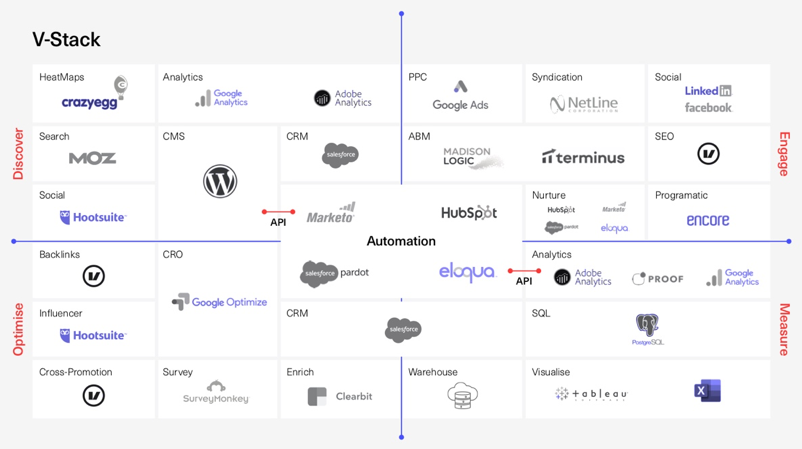Some marketers only care about what happens before someone fills in a form. And some marketers only care about what happens after the form fill.
This post is
for the folks who care about the whole journey.
The ones who
know that just making some content and hoping for the best isn’t enough. As
well as the ones who know that even the most logical demand generation system
is no use without the right creative.
Because in marketing, as in physics, a perpetual motion machine is impossible.
A system needs an energy source. And content is B2B marketing’s greatest energy source – but only if it’s properly plugged into the system.
That’s why you
can’t, under any circumstances, allow content production to become a silo. It needs
to be integrated with everything you know about your prospects, the channels
you’ll use and the longer-term impact you’re trying to have on your market
(yes, even if you’re most worried about your next six months).
Put it this way
– where do you want to be in six months’ time? Running a content portfolio that
sits outside a demand generation system or a content engine that’s
tightly integrated inside the system?
Flywheel Marketing: building a demand generation system
A content engine forms part of a system often known as flywheel marketing.
Rand Fishkin’s
book “Lost and Founder”,
a must for any marketer, describes the metaphor as coming from “a piece of
machinery from the industrial revolution that…could be used to power any number
of systems that require a constant output of energy”.
The idea is to
create a positive feedback loop between the people you’re trying to reach and
the content and tactics you’ll use to reach them – to make the whole greater
than the sum of its parts.
At Velocity, we use something we call the SpinCycle™ methodology to ensure the energy from our content reaches into every part of our client’s marketing system.

It’s a simple
model to make sure all the pieces of your complex demand generation engine work
in a coordinated way.
And I think it’ll help you think more broadly about your funnel. So let’s look at each step in more detail.
Step
#1: Discover
This first step
is all about learning. We have five core audits we rely on.
| Audience | Search | Analytics | Industry | Competition |
| What we’re looking at | ||||
| Qualitative input Insights from automation and CRM systems. | Direction on best keyphrases from search tools | Core baselines from analytics packages | Data from key prospects and influencers | Inside information on competitive marketing tactics. |
| What we’re trying to create | ||||
| Scoring patterns Segmentations Correlations Conversion paths | Search potential Opportunities Top clusters Activities | Goals Journeys Conversions KPIs | Stakeholder map Social scores Amplification Campaign score |
PPC focus Page messages Strengths Weaknesses |
Every data
point improves your likelihood of creating high performing content. Because all
those audits help you know for sure if your content is:
- Audience-first
- Search-optimized
- KPI-driven
- Journey-aligned
- Channel-friendly
- Socially-sharable
- Competitively-framed
Without this
first step, everything is guesswork. With it, every decision becomes easier to
make.
Step
#2: Engage
The next step
is about understanding the relationship between your content and channels.
It’s about creating
content-friendly channel strategies where you know content demand is high.
| Search | Social | Automation | Web |
| How do we optimize content with open keyphrase clusters to drive organic visits and SERP features? How do we prep content for PPC campaigns to focus on lead acquisition for nurture and retargeting campaigns? |
Can we amplify your content with influencer outreach and data capture to drive organic campaigns? How can our audience assessment and segmentations make our paid efforts more focused? |
How would we structure our content into short, sharp nurture flows based on core triggers? How can we craft clever, personalised responses that map back to where they are? |
How do we flow our content to align with inbound patterns and established customer journeys? What content would reflect what a persona is likely to be feeling, thinking and looking to do next? |
These are all
important questions to find answers to. But if you’re in a big company or even
just a big marketing organization, finding these answers can be a problem.
Because it
doesn’t matter how big-picture your vision is if you don’t have cross-team
buy-in.
The tricky
thing is that the people you’re seeking buy-in from have little reason to give
it. They didn’t invent it. They don’t understand it. They don‘t have a plan for
it. They don’t think you understand them.
There are three
things you need to do:
- Engage
teams – Show you’ve
listened to them - Focus
on outcomes – We’re
here to optimize not invade - Create
a blueprint – Use data
to layout where content and channels meet
At the end of the day, all the elements of your marketing organization need to be working together to create a content-powered demand generation system. So tricky as these steps may be, there’s no avoiding them.
Take the silo survey
Silos are the enemy of B2B marketing. They confuse strategies. Slow down ideas. Generate conflict. Find out where you sit on the silo spectrum relative to your peers – Take the survey today
Step
#3: Measure
Your future
self’s hero status is dependent on you putting in the right reporting
framework.
Failing to prove performance is tantamount to not providing it. It’s all about putting in a framework, from day one, that mixes creative, data and actions for reporting.
| KPIs |
Content Metrics |
Journeys | Channels | Funnels |
| What we’re trying to achieve | ||||
| Impact on the big metrics that really count. | Bespoke content metrics for deep dives | Insights into key point content conversions | Exploring cross-promotion channels | Using customs for cool content insights |
| Measures of whether we achieved it | ||||
| Visits Leads MQLs Opportunities |
Plays Progress Scrolls Clicks |
Starts Drop-offs Conversions Return Visits |
Distribution Attribution Amplification Lead Scoring |
Leads Opportunities Pipeline Revenue |
All of these reporting strands are fundamental to any content strategy.
Step
#4: Optimize
There’s no
point in measuring stuff if you aren’t going to do something about what you
learn. So in six months’ time you want to be optimizing your content engine to
keep expanding your KPIs.
Here are five
things your future self will want to be doing.
|
Creative Experiments |
Format Extensions |
Campaign Expansion |
Conversion Optimization | Calls To Action |
| The biggie. An ability to try galvanising messages, options for current and new audiences | Launching new content formats like emerging digital content into a true learning environment. | Building advanced outcomes such as content to drive backlinks or engaging ABM contacts | Responding to traffic analysis to boost content conversion both before and after consumption. | Working with your team to offer your engaged prospects something more than a contact us button. |
The idea is to craft hypotheses that drive a consistent aggregation of gains. If this piece or this channel is performing in this way, what might we do to get more of the good stuff?
You’re trying
to understand:
- Who you want to target
- What
you want to achieve - Why you think something is a good idea
- Where you think it will thrive best
- When
you believe it will
work best
Planning
your tech support
Finally, once
you’ve laid all that groundwork – you’ve done the hard yards in discovery,
you’ve crafted a plan based on both your content and your channels,
you’ve set up a reporting framework – you can start thinking about your tech
stack.
You need the
structure of your demand generation system to think about what tech you need
and when you need it.
This example looks at various technologies and services we’ve worked with over the past year to highlight the scope of integration, opportunities and holistic outcomes.

So, what do
you think?
Most content
marketers won’t be responsible for an end-to-end demand generation system. But
you are responsible for your content’s performance at every step of the way.
And that means optimizations every step of the way.
Equally, if
you’re a demand generation person, you won’t be responsible for what creative
gets made. But that creative will impact your results.
So rather than avoiding each other, it’s important we do the hard work needed to work in positive, complementary ways that help move the same needles.
That’s when you
go from being in silos to being in a flywheel.
Enjoyed this article?
Take part in the discussion









Comments
Joady sole trader June 10th, 2020
Great post!
Joady Sole Trader June 10th, 2020
I meant to say … great post! Informative and inspiring. Thank you.
Doug Kessler June 22nd, 2020
Thanks, Joady!